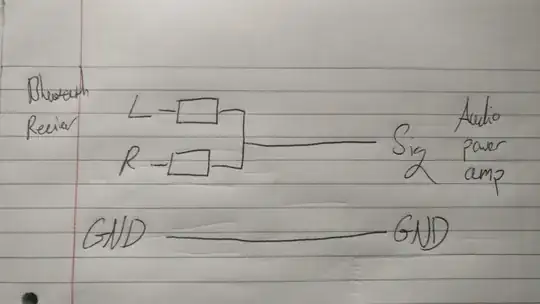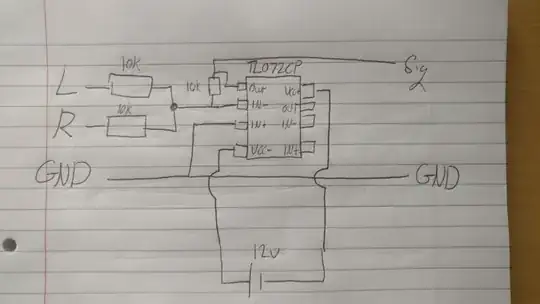just wondering how to sum stereo to mono signal? I am aware that you can use resistors in series to the left and right outputs of say a Bluetooth receiver module but when i do this, the channel does sum but the quality is horrendous on the high frequencies, sounds like a low bit rate mp3? Does anyone have a solution to this? The parts that i am using is a sure 30watt mono amp, and a sure Bluetooth receiver module 4.0 aptx etc... Thanks i would really appreciate this as i have been pulling my hair on this speaker build 

Asked
Active
Viewed 2,652 times
1
Fabrizio Catinella
- 11
- 1
- 3
-
hm, a schematic might help. Generally guessing: is it possible you have the summing resistors, and then a significant length of cabling? Also, by the way, it's probably sound-quality wise a good idea to not transmit stereo over bluetooth just to mix it down to mono at the receiver, since bluetooth audio is mostly compressed and having one only slightly compressed mono channel will probably sound better than the mix of two channels compressed twice as heavily. And transmitting mono from the start would solve your analog problem alltogether. – Marcus Müller Apr 14 '17 at 10:26
-
Hey, thanks but I've tried using just an aux cable with this same layout, around 470 ohms on the resistors and it still has this weird sound on the high frequencies more than likely some sort of distortion or crosstalk? , but when i just use one channel (for example using only the left channel) it's completely fine and there is none of this distortion but i lose the signal from the right channel? – Fabrizio Catinella Apr 14 '17 at 10:40
-
Also, transmitting mono isn't really option as many audio files are stereo so when streaming music, it's kinda hard to force mono through like a phone via SoundCloud or Spotify? – Fabrizio Catinella Apr 14 '17 at 10:42
-
1Mono is easy. Just configure your Operating system to downmix to mono. Has nothing to do with spotify. Your player doesn't know about bluetooth. – Marcus Müller Apr 14 '17 at 11:16
-
if you add resistance in series with your signal, and then have a long cable, you've built something that resembles an RC low pass filter (because the cable might contribute significant capacity). – Marcus Müller Apr 14 '17 at 11:18
-
Also, check the input impedance of your amplifier – it's quite likely that your pair of resistors is the "preferred path" for current, since the input impedance of the amplifier is much, much larger. Make your two resistors larger (10kΩ?) and add a e.g. 47 Ω resistor between Sig and GND close to your amplifier. – Marcus Müller Apr 14 '17 at 11:29
1 Answers
0
Two resistors is the simplest way. These should be significantly higher than the output impedance of whatever is producing the stereo signals. That way, the signal from one channel doesn't mess up the output of the other channel. You may have to buffer the result to get it back to a reasonable impedance.
With a opamp, you can make a classic summing amp. These have the characteristic that each input only sees a resistive load to ground, not the signal from the other channels. Here is the basic topology:
OUT = -(In1 + In2 + in3 + ... + InN)
The output is also nicely low impedance due to the feedback around the opamp.
Olin Lathrop
- 313,258
- 36
- 434
- 925
-
Thanks, guessed that something like an opamp would do the trick, I'll try this later – Fabrizio Catinella Apr 14 '17 at 12:04
-
What opamp would you recommend? Currently i have a tl072cp on hand and have no idea how to power this thing, can i use a single rail supply? I this it's like this? I'll add a photo of the schematic above – Fabrizio Catinella Apr 14 '17 at 14:06
-
@Fab: TL072 is fine as long as you give it wide enough +- supply, like +-12 V. – Olin Lathrop Apr 14 '17 at 14:31
